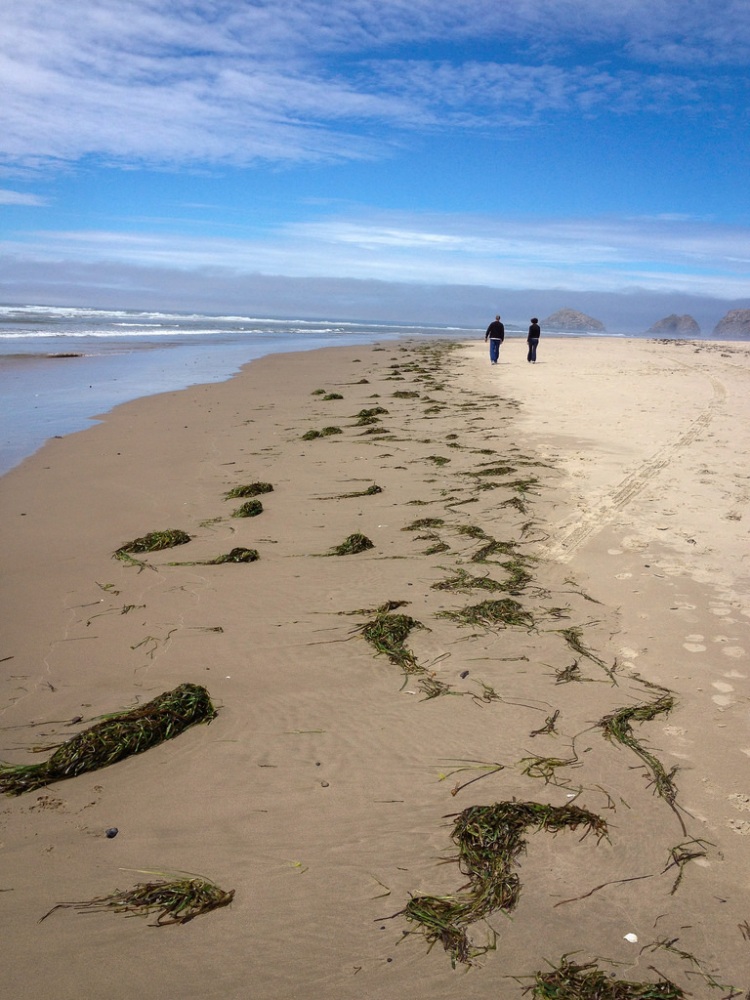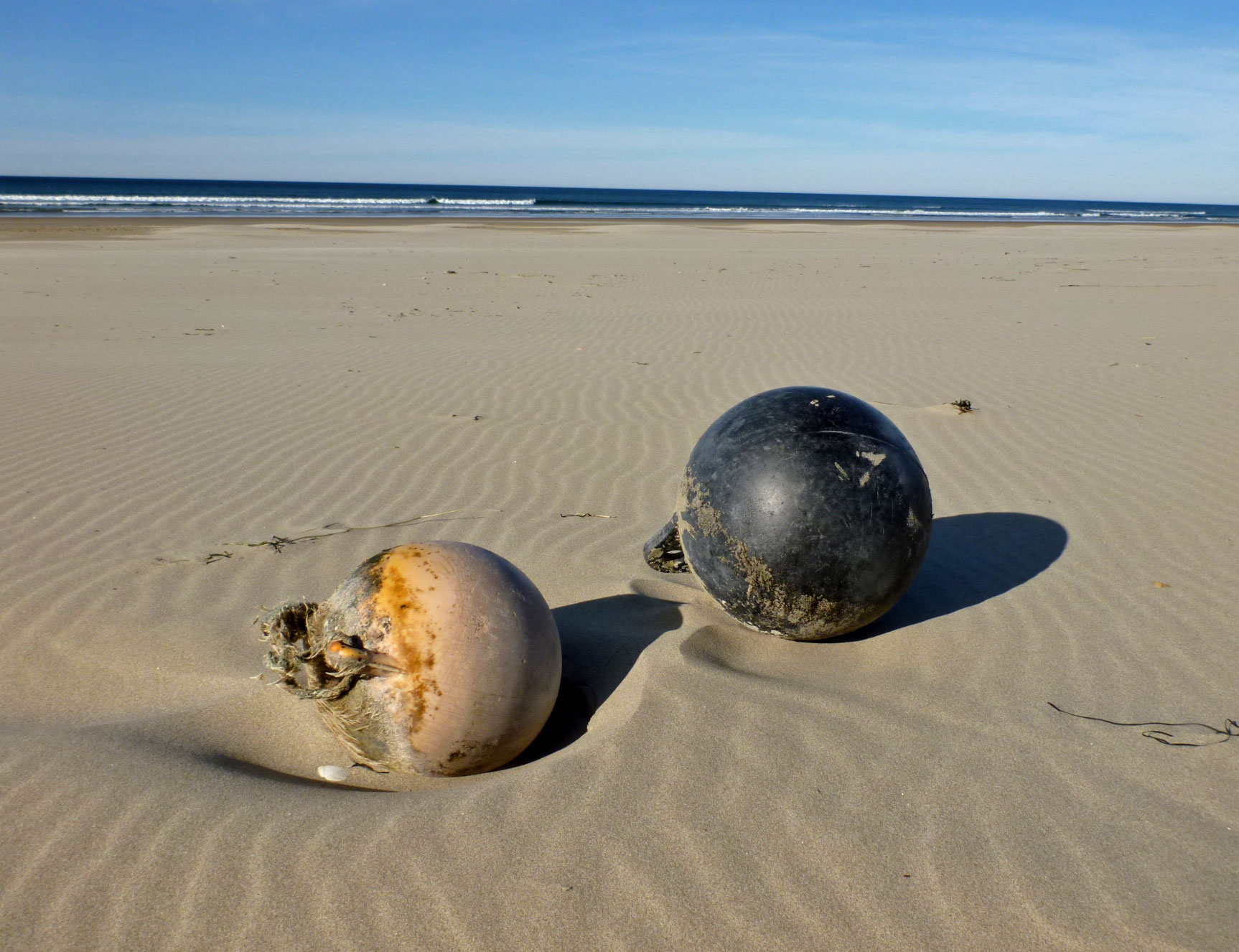Wrack Line through the Years– There are always interesting things washing up on the shore. Sea wrack is made up of dead sea life and plants and animals that have drifted in from sister ecosystems, the estuaries and the maritime forest. The other thing you’ll find in sea wrack are items of human origin, fishing gear, empty bottles, and lost items. It all has a story to tell.
Click an image for a gallery of that year’s wrack line discoveries.
What’s the Wrack Line?
The wrack line is the line of debris left on the beach by high tide. The wrack is usually made up of eel grass, kelp, crustacean shells, feathers, bits of plastic, and all kinds of litter. You will also find bird and mammal carcasses and things like pallets, boards, branches and small logs, and pieces of crabbing and fishing gear and and things that have fallen or been thrown from boats.
The more substantial wrack accumulates above the main beach on a shelf at foot of the foredune or in the cobbles at the base of a cliff. No shelf, no accumulation. Up above the main beach is where you’ll find the biggest logs and stumps and timbers. The big stuff, mostly big wood, gets deposited when surf and high tides combine for a big push up the beach.



Drift line is another term people use for debris left behind at high tide; I use it myself. I use wrack line and drift line somewhat interchangeably, but I lean towards using wrack line for higher, drier, possibly bigger material associated with the higher tides, and drift line for smaller wet material left by any old high tide; but I’m not strict about it. This page, for example is called Wrack Line; it’s an umbrella for all things drifting in on the tide.
The composition of the drift line varies a lot over time and space. Sometimes the contents are very specific.




I love checking out small stuff in the drift line.



Here are a few bigger items.



























You never know what you’re going to find in the wrack line. It’s make-up varies beach by beach, with the seasons, and year to year. The links below are to year-by-year compilations of all kinds of things that have drifted with the tide onto my home beaches. Pick a year!
2012, 2013, 2014, 2015, 2016, 2017, 2018, 2019, 2020, 2021, and 2022.
This page was updated on September 21, 2022.














Do you ever find useful or interesting items in the wrack line? What’s the most surprising thing you’ve seen there?
Hi megmi, I have found a few interesting things in the wrack. I have found some floats and beads from fishing nets. I like those. I once found a meteorological or oceanographic recording device, apparently broken free from it’s bouy. And of course, lots of marine plants and animals that don’t live on the sandy beaches occasionally make an appearance in the wrack. I’ll post pictures of neat stuff I encounter.
You should have a gallery of just Floats! Is this an unusually large number, or are there always a lot of them washing up?
I like the hitchhikers! Is that one hitching a ride on a hitchhiker?
Too bad that bottle is empty… might have had an interesting note. Do you ever send messages into the ocean? Have you found any messages?
A float gallery! Great idea. I haven’t decided how to organize the Wrack Line images. Thanks for the suggestion. May 5 was a big day for floats and bottles. These are probably tsunami debris. Normally floats are kind of few and far between in the wrack. The hitchhiking snails are probably leafy hornmouths, but I’m not 100% certain. I haven’t found a message in a bottle yet but others have; it’s not too uncommon. I’m looking forward to finding a message some day.
If you are a fan of nachos, with real cheese, (not that gooey pseudocheese often called “nacho cheese”) you are probably familiar with the concept of “The Chip”. That’s the one where you pull it, and half the plate of nachos comes with it: chips, sour cream, guacamole, beef, salsa, that’s “The Chip”. I’m usually trying to find “The Chip” whenever I get nachos.
This is a pic and story about “The Float”. This is a dock from Misawa, Japan, which washed up onto Oregon’s lovely coast somewhere. (http://news.nationalgeographic.com/news/2012/06/pictures/120613-tsunami-dock-japan-oregon-aliens-invasive-species-science/#)
This story mentions invasive species, but isn’t specific about which ones might be a problem. I guess we’ll find out which ones when they become established and spread and create difficulties for natives. Is there a good way to predict which ones might be a problem? The NatGeo site with this pic has another of people from Oregon Fish and Wildlife scraping everything living off for disposal. I would imagine it could be a bit late for some things which are already growing in the waters on/near shore now, but better late than never.
Saw this, thought of you. Would love any insight you have on this.
Just found your wonderful blog when I googled “wrack line”. We walked the beaches between Ucluelet and Tofinio in May but found only four plastic water bottles with Japanese inscriptions. May have been tsunami debris but could also have come from normal ship traffic. Beaches were surprisingly clean. Found a few pieces of styrofoam .
Hans at “Boerger West Coast Nature”
Thanks for checking out theoutershores. I’m glad you like it. Like you, I love it when I get a chance to do some beachcombing.
Some fabulous images and a really interesting read, thank you.
I appreciate hearing that. By the way, I just spent an enjoyable few minutes going through your Photo 101 posts. Inspiring me to try something like that. Thanks.
Very interesting! I’m happy to learn the name of that part of the beach where the stuff washes up in kind of a line 🙂 I like looking through that too and finding tiny versions of shells.
I’m with you Cynthia. A walk on the beach promises lots of treasures. By the way, I enjoyed what you did with Weight(less).
Thank you, I’m glad you enjoyed my posts.
Cool blog, and gorgeous photos. My favorite? The turkish towel. Happy beach combing. Cheers —
Kind of you. We have similar taste in marine algae.
Living by the sea would be the ultimate dream for me. Love your photography 🙂
I believe it. Loved your post on fish leather and that amazing shop.
There’s part of me that feels uncomfortable about the wolffish key ring we bought, I’d prefer the old wolffish to be gliding around in the depths. 🐟🐟🐟
We came across your beautiful and peaceful site while looking for a good definition for wrack and wrack line. My wife and I are beachcombers by nature. Living on the Olympic Peninsula provide us hundreds of hours of walking on isolated and beautiful beaches. We have also visited several times the beautiful beaches of Oregon’s coast. Now we live in Peru, South America and the beach is only 5 minutes from our door. Since there is a river not many miles south of us we get a lot of “wrack,” wreckage or trash if you will. However, a lot is very wave tumbled and picturesque and we use it for eco art. Mainly, though we look for sea glass, the basis of our site, OdysseySeaGlass.com. Have you ever run across Stu Farnsworth, the glass fishing float fanatic? Check some of his exciting experiences along some of same coastline you cover – and his amazing collection of floats. Just Google odyssey glass floats. We’re looking forward to reading and especially seeing your sojourns along that beautiful coastline.
Thanks for the nice words about my site. I appreciate your reference to it being a peaceful site. That’s how I think of it. Thanks for pointing me to your webpage – I just subscribed. As you can see from my Wrack Line pages, I need to up my glass game. Your site will be a big help. Coincidently, I only know Farnsworth from browsing Sea Glass Odyssey last fall before the big winter high tides. Now I can connect the dots! With luck I’ll run across a polished prize or float before long.
I am creating a smart phone app on the geology of Cape Cod and wish to include a link to your wonderful blog. It would appear in the tour stop at Sandy Neck beach in the following context:
“Lastly, the high tide line on each beach is marked by the Wrack Line, which is made up of all the stuff that’s washed up along the shore. It can be simply a ridge of sand, or,more likely, seaweed, shells, debris from boats, fishing gear, boards, branches and even the carcass of hapless sea creatures. For more info see: Wrack Line”
The App will be available for free on-line and will monetize through selling ads. Perhaps we can encourage viewers to send you their own pictures?
Yours,
Damian Musello
617-650-6480
Count me in. Please let me know when your app comes out. I’ve got a lot to learn about coastal geology.
hello, I’m writing a paper about the beach wrack and any sources to research about beach wrack would be much appreciated-my girlfriend and I go to the outer banks, NC once a year-sandy beaches with beach wrack.. thanks much Stan great photos……. do you have email? thanks
This is a wonderful post. Simply so much to see for those who take the time to look. Oh … did I see a picture of a bowling ball?